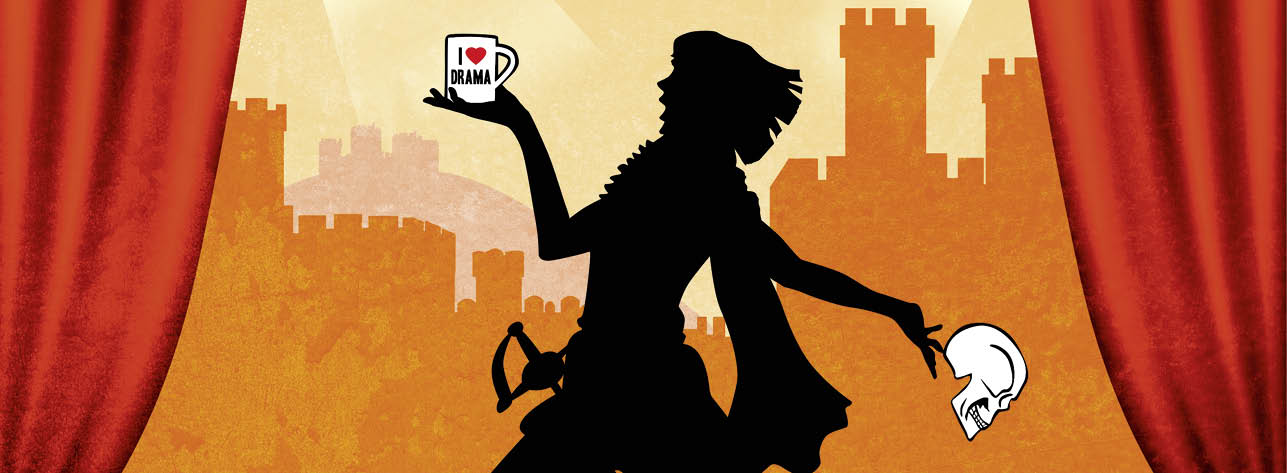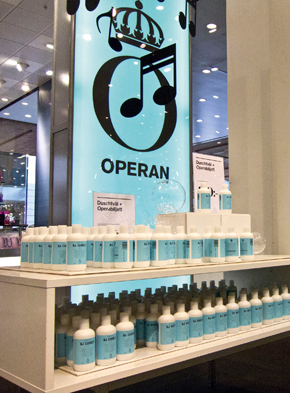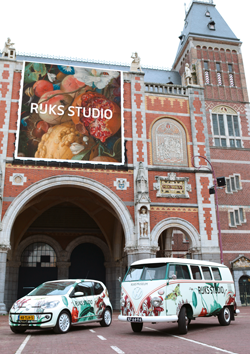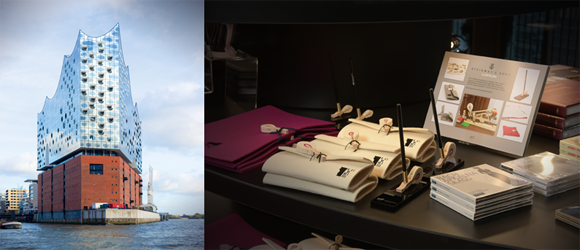Whether a cabaret, a museum or an opera house – cultural institutions live from visitors. In order to attract and bind these, art and advertising have to go along hand in hand – corporate design and Camille Claudel, brand image and Bach, target group focus and Tosca. After all, even fine art needs filthy lucre.

According to a survey by The Art Newspaper, 7.4 mil. people visited the Louvre in 2016, 7 mil. the British Museum in London and 6 mil. the Vatican Museums in Rome. The Prado in Madrid counted 3, the Van Gogh Museum in Amsterdam 2.1 and the Uffizi in Florence counted 2 mil. visitors. Concert halls, operas and theatres remain busy too. In this way, according to Operabase in the 2015/2016 season there were 535 opera performances in Vienna alone, in Berlin 527, in London 427 and in Budapest 400. In spite of the cultural decline that has been prophesied for decades and the budget cuts that occur every few years, it doesn’t seem to be the end of the day for cultural institutions yet.
However, to keep up programmes and to be able to work viably long-term, additional sources of income are often needed. Many institutes from private theatres through to the state opera are increasingly relying on merchandising in order to reach their target group. “Cultural institutions are getting involved in commercial matters more and more, especially if one can reach a wider public through media such as merchandising products. Countries like the USA or the Netherlands are impressively demonstrating here the extent of the potential,” explained Christian Himmelspach, one of the bosses of the Berlinbased agency for brand communication, Seyffert mit Himmelspach, which cooperates with several museums. For example, the agency develops promotional products for the Victoria and Albert Museum in London and the State Museums in Berlin, which have been directly developed from the respective exhibitions – “Botticelli Reimagined“ and “The Botticelli Renaissance”. “These include for instance a sleep mask with the eyes of the Venus of Botticelli as well as a high-quality towel with an imprint of the naked God of Love,” stated Himmelspach. An item that the curators in London really liked was a hairdryer displaying the image of the God of Wind, Zephyr, who in the painting “The Birth of Venus” blows the West Wind towards the goddess so that she can reach the shore. “The development of such products always arises in close collaboration with the curators of the respective exhibitions and the sales partners,” added Himmelspach. “We were surprised by the success of some things ourselves. The rather high-priced Venus towel proved to be the absolute bestseller, which was probably not least due to the beautifully staged example of application on the packaging.”
Enhancing experiences

Sold at a Stockholm department store, the “Opera Soap” from the Royal Swedish Opera attracted new target groups to the opera house.
The Scala in Milan not only let its name speak for it – after all it is one of the most famous opera houses in the world, which is visited by hundreds of thousands of people every year, it also implements the pieces of work that are associated with it. The highlights of the in-house merchandising collection include T-shirts and shopping bags with facsimiles of posters of famous opera performances – from Aida and Carmen, to La Bohème and Don Giovanni through to Tosca, La Traviata and Turandot. “The name Scala is automatically associated with the opera,” explained Annalisa Toniatti, Digital Manager at the Italian agency Sadesign, which was responsible for the collection. “That is why we have made the operas the protagonists of the collection. Beyond this they also offer the highest potential for identification for the visitors of the Scala. We have had a lot of positive feedback from visitors. For opera lovers even the ‘simple’ gadgets are something special. For many it is as if they are taking a little piece of the Scala home with them.”
The Saarland State Theatre in Saarbrücken, West Germany, which attracts around 200,000 visitors annually, offers a promotional product of the special kind, which records and conveys what has been experienced perfectly: an upcycling bag. The idea arose internally, as the costume director, Markus Maas, reported: “Our orchestra manager came to me with a daily concert poster – a banner that advertises the evening performance on the façade of the building and said the advert was made out of thick fabric material, but was always only used for one performance, whether it wouldn’t be possible to reuse it afterwards? This led to the idea of having bags sewn out of the fabric. Depending on how one integrates the motifs and the letters in the design, it can be made into a great designer item.” For Ellen Brüwer, Marketing Director of the theatre, the charming thing about the models is “that by implementing the daily advertisements a material is used that arouses associations and emotions among the public. We prevent the materials from being thrown away and at the same use them as a form of discrete advertising.” The production in the in-house costume department creates an additional connection and opens up further possibilities, explained Maas: “Contrary to merchandising items that are assigned over to external service providers, we can further develop the bags in line with our own ideas and react to enquiries in a targeted manner.” Further promotional products underline the merchandising concept: “We stock image-related merchandising such as theatre cups made of bone china imprinted with a Faust quote, beautifully designed pencils or snow globes with a picture of the State Theatre that go down very well, as do our writing notebooks with a selfdeveloped logo and high-quality paper,” reported Brüwer. The brand presence is rounded off with own book publications. In this way, the knowledge transfer doesn’t get a raw deal either.
Conveying knowledge
An institution where the educational task in marketing plays a particularly important role is the Neanderthal Museum in Mettmann. The Museum of Human History that was built in 1996 on the site where the human fossil was found sees itself as a multimedia experience institution for the lifestyle of the Neanderthals. Every year the museum that raises a considerable share of its operating costs itself grants around 160,000 visitors insights into the early history of humans. The museum’s own shop was redesigned around ten years ago. When the items were subsequently chosen the strongly represented young target group was taken into account. “Our visitor structure comprises of families, individual people and school classes, each category accounts for a third of the visitors,” explained Petra Jäschke, Director of the museum shop. “Our product range is very colourful – starting with the rubber ducks in the form of a mammoth or Neanderthal, to colourful storybooks, through to erasers in the shape of sabre-toothed tigers. Since our subject area is limited and one doesn’t directly find something to match the topics of the Stone Age and evolution at every trade show, we have designed some products ourselves, like our popular plush mammoth, Tinka. And for instance to provide teachers with a product that they can use to convey what was experienced in this era in the classroom, we have designed the Stone Age Lighter and the Stone Age Drill that are made out of flint stone and birch wood.“ The team of the Neanderthal Museum also takes the feedback of the visitors into account when selecting the products. In this way, over the course of the past ten years a balanced collection has come together, which transports the contents of the museum into the living environments of the visitors.
Art for everyone

The Rijksstudio provides art for everyone and everywhere: the possibilities to decorate products with the pictures from the Rijksmuseum seem endless.
The British Museum also offers its visitors and fans “history for at home”: It has been possible to examine numerous exhibits of the world-famous museum as 3D animations online since 2013, in some cases they can also be downloaded. Since recently, some of the most famous pieces – including the Statue of Roy, Priest of Amun or Antinous – are also available as deceptively genuine replicas that are sold via the museum shop online and offline. “The objects are cast from reusable moulds in Jesmonite – a water-based resin commonly used in museums – with the potential in the future to produce a variety of materials – even chocolate one day,” Daniel Pett, Senior Digital Humanities Manager, explained. The British Museum Company intends to include further artefacts into its collection of models soon and thus make world history experienceable for everyone at every location beyond the environment of the museum. The Rijksmuseum in Amsterdam even goes a step further with its Rijksstudio project: Since 2013, a huge part of the museum’s collection has been made available online. This image database is the central element of the Rijksstudio project, which makes the Rijksmuseum open and accessible to everyone: All of the pieces of art digitalised so far – in the meantime that’s around 300,000 and new ones are added to the list every day – are available to every visitor of the Rijksmuseum website as a free download. Indeed, in a high resolution so that even small details of big paintings can be printed out as an extract.
One can look for pictures using the Rijksstudio and create one’s personal collection on the website – there are almost 100,000 such collections in the meantime. The special feature about the whole project: All of the images can be used to individualise products. T-shirts, cups, mobile phone cases, book covers, wall tattoos – the fantasy is set no limits. Not even through a copyright. Everything can be implemented by everyone, hence art becomes not only universal, but also touchable. Two possibilities are available: On the one hand, there is the Rijksmuseum online shop, which enables posters, postcards and other printed products to be decorated with art motifs. These are then produced by a partner printing shop of the museum and dispatched. The other possibility is to download the images and use other printing and customising suppliers by own choice. In 2017, the Rijksstudio organised a competition for the best pieces of work with the masterpieces for the third time. Around 2,600 entries from 62 countries were evaluated by an international jury – the winner: “Masterpieces never sleep” by Lesha Limonov from Belarus, which imprints pairs of eyes made out of well-known masterpieces on sleep masks. The Rijksmuseum achieves several goals simultaneously with the Rijksstudio project: It achieves significant PR effects, it demonstrates in a charming way that art belongs to everyone and it gains access to totally new target groups by meeting them where they meet up: online. Last, but not least the Dutch Institution is presenting itself as a contemporary cultural site.
Building cultural brands
Kerstin Falken, owner of the corporate consulting company, KFMC merchandising concepts, who created the overall concept for the shop of the Elbphilharmonie (Elbe Philharmonic Hall) in Hamburg also knows how important a tailormade solution is for a cultural institution. “The planning for the Elbphilharmonie was very exciting, because the aim was to combine exceptional architecture with a demanding cultural programme with the political claim ‘The Elphi is there for everyone’. What’s more, all of this in a special location – Hamburg, the gate to the world. Regarding the selection of products we thus had to do a balancing act between a concert hall and tourist attraction and come up with items for every budget that nevertheless still satisfy a certain standard,” explained. In order to do justice to the niveau of the institution and yet still address a broad public, the “storytelling” aspect was important. Here the selection of the partner companies, that Kerstin Falken and her employees had made, was a key aspect: “As a local I found it important to work together with Hamburg-based companies on this project. We drafted collections among others together with local artists such as The Art of Hamburg, the genesis of which we explain on small displays in the shop. When the visitors realise that local designers are involved, that the items are produced locally and social aspects such as the involvement of the Elbe Workshops are taken into account, they accept the prices more readily.” The exceptional products among the collection include the Steinway items, which directly pick up on a characteristic feature of the concert hall: The pianos used in the Elbphilharmonie are of the famous brand Steinway & Sons. During a guided tour of the Hamburg manufacturing company Kerstin Falken came up with the idea of using old hammer heads as closures and decoration for among others felt folders containing music notes – similar to the classic duffle coat buttons: “I find the folders very special. By using the original parts from the Steinway & Sons production chain for other purposes we are implementing the themes music and lifestyle in an exciting way. It is true that we only reach a certain target group with this idea, but this special form of address is part of our concept – anyone can do mainstream.”

The shop of the Elbphilharmonie: Reject hammer heads from the production of Steinway pianos decorate exclusive folders of music notes, spectacle cases and pen butlers.
How creative and “anti-mainstream” marketing can be even for venerable cultural sites the Royal Swedish Opera has often demonstrated using high-profile campaigns– one of these is the “Opera Soap“, a collaboration with DDB Stockholm. Here, a product that at the first glance is rarely association with musical theatres is used as a haptic messenger: Shower gel. However, indeed a thoroughly logical thought process triggered off the ideal for the campaign – namely that many people enjoy singing an aria while they are under the shower. With this in mind special developed shower gels for the three famous operas – Carmen, La Bohème & Tosca – were offered for sale on a special zone in the Stockholm department store Åhléns. The bottles were imprinted with the text so the hobby opera singers could practice under the shower and the label also doubled up as an admission ticket for the respective opera. According to Torbjörn Eriksson, Press & Information Director of the Opera, a campaign that really attracted the attention of the media and the public: “We were mentioned in the press many times and certainly attracted some new and young audiences to the Opera.” Of course, not every cultural institution is game to engage in such unconventional ideas. But regardless of which figurehead institutions ultimately opt for – those who strike the right note with the implementation and successfully convey their programme, will be rewarded with the attentiveness of the public.
// Claudia Pfeifer
photos: Alexander Kenney (1); Iwan Baan (1); Jens Friedrich, © WA Media (1); KFMC merchandising concepts (1); Rijksmuseum (1)



